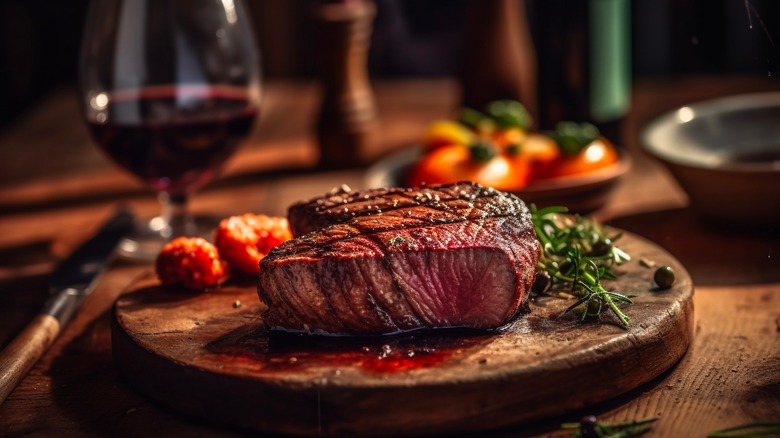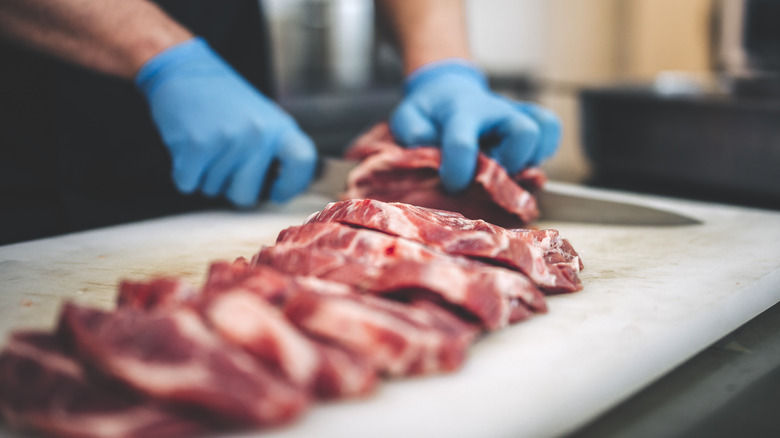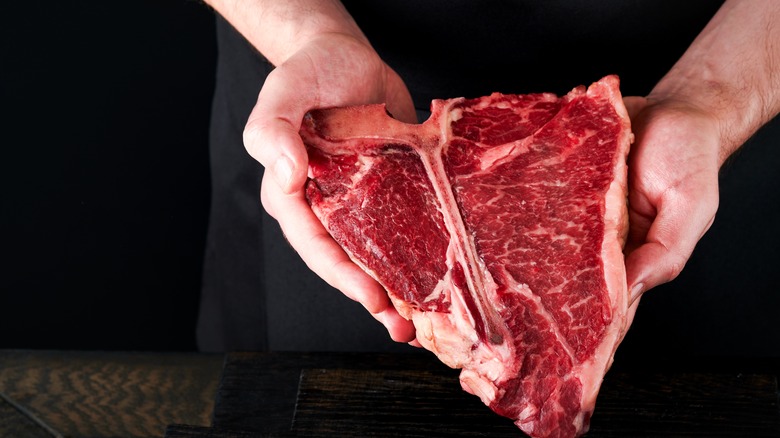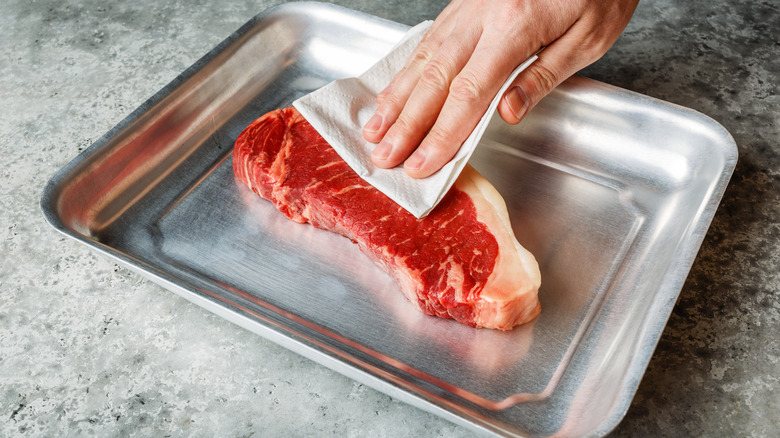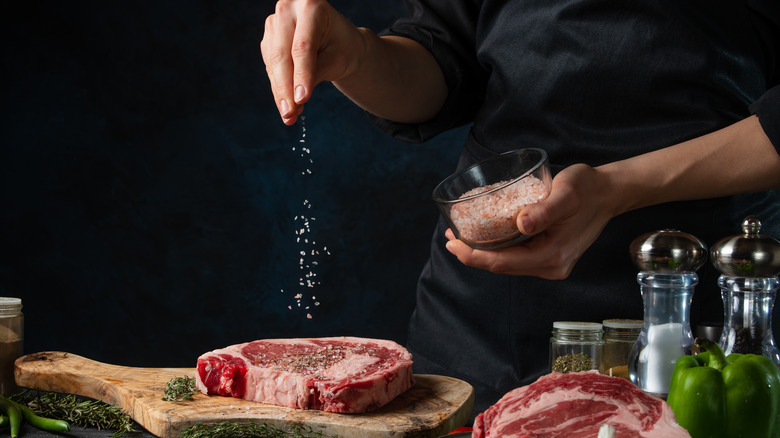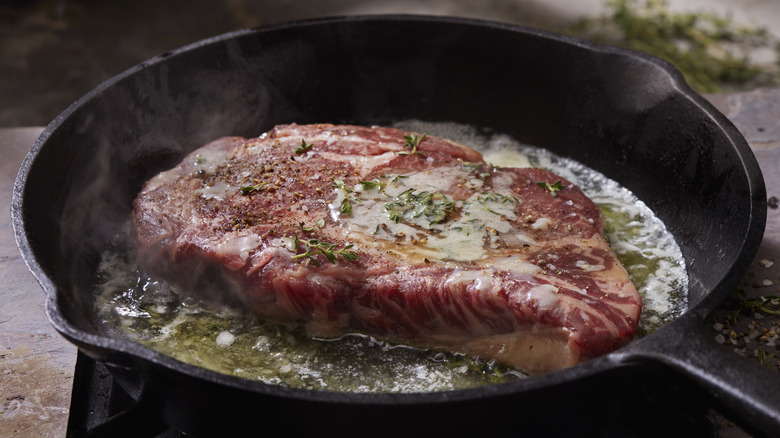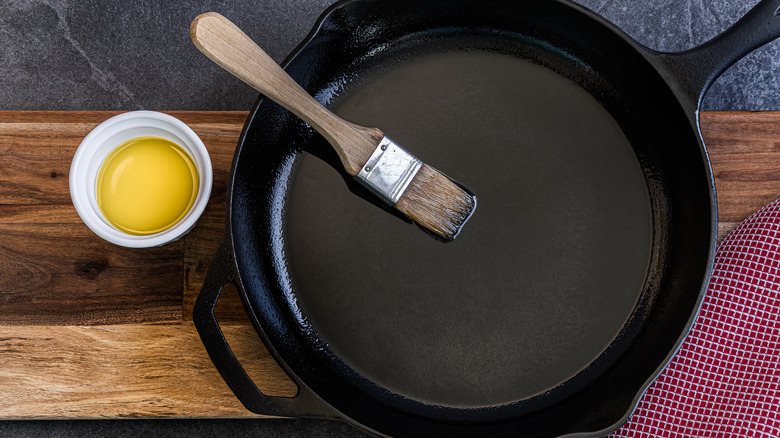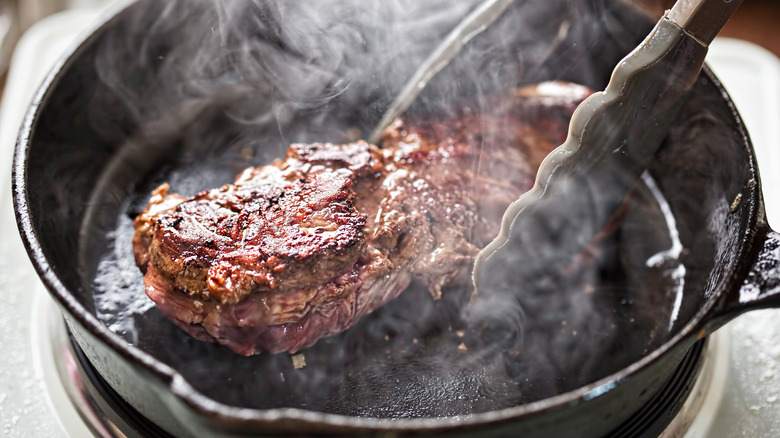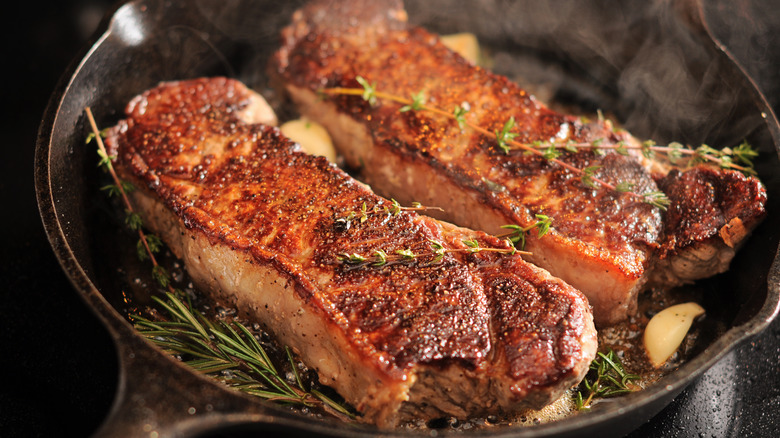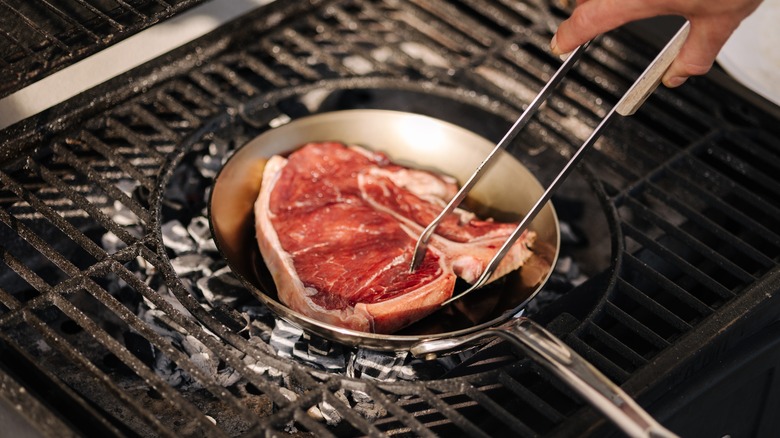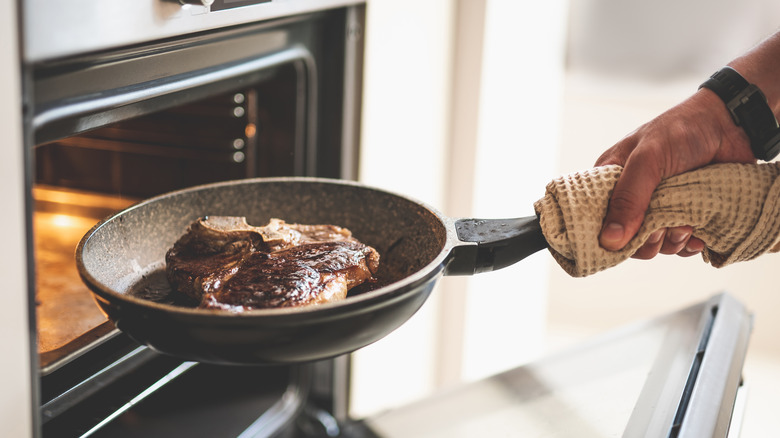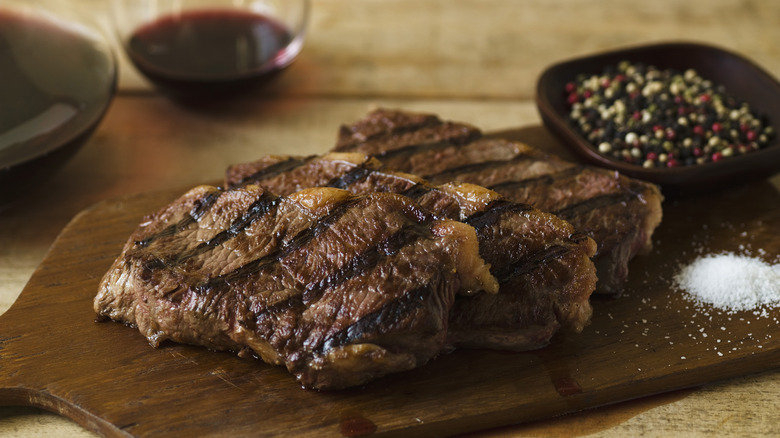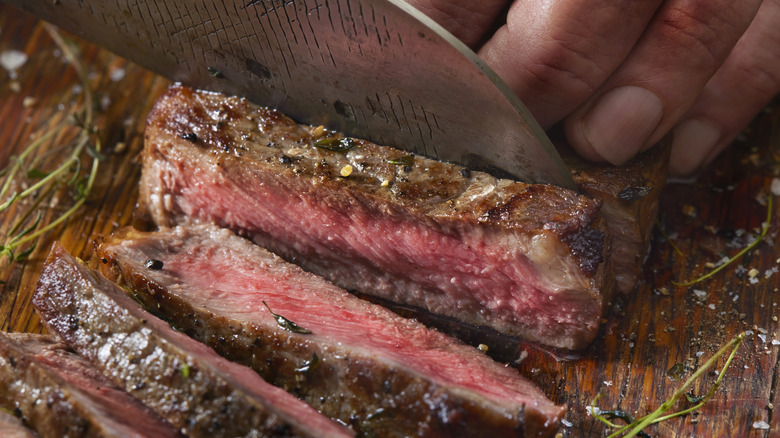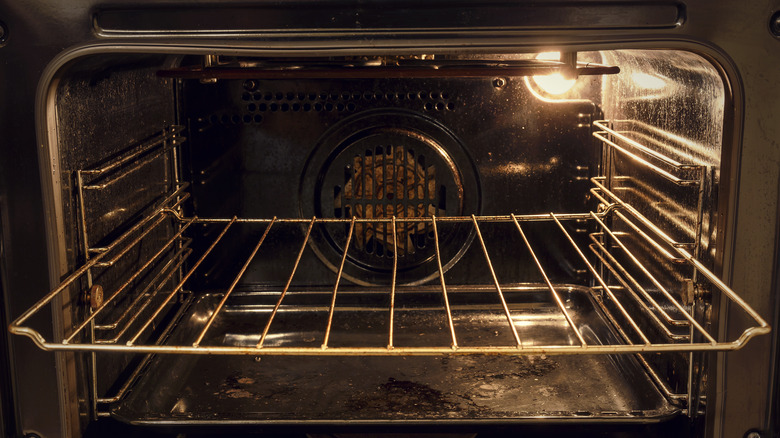Mistakes That Are Ruining Your Pan-Seared Steaks
You've seen it on every major cooking show, ever: Chefs flawlessly executing a beautiful pan-seared steak. They're basting it with butter, there's a perfect sprig of thyme or rosemary nestled alongside the cut of meat in the pan, and a golden-brown crust is starting to form. Once it's rested, the chef cuts into the steak and it gives under the pressure of the knife like butter, revealing an ideal medium rare, cool red center.
Being able to recreate this culinary masterpiece may seem like a tall order. But with a few helpful tips — including knowing what commonplace mistakes to avoid — you, too, can execute a perfect pan-seared steak that'd make Gordon Ramsay say, "Well done." From not using the correct pan to skipping the seasoning of your meat to not making sure that the cut is good and dry before it ever hits the heat, here are several mistakes that are ruining your pan-seared steaks — and how to avoid them.
1. Choosing the wrong cut
The first step in avoiding any mistakes while creating your pan-seared masterpiece is to choose the correct cut of steak for the job. Perusing the butcher counter at your local shop or the endless array of cuts at the supermarket can feel daunting, to say the least. But understanding which cuts will give you what you want without being difficult to work with will aid in your quest for perfection.
Beef tenderloin, strip steak, and ribeye are three of the best cuts for pan-searing. Ribeyes and strip steaks lend themselves well to grilling, too, since they're relatively thicker cuts and can handle high heat without drying out. Although it's the most expensive of the options, a tenderloin is likely going to work best in the pan-seared arena, since it's smaller, does wonderfully when basted with butter, and can easily be maneuvered around your pan. Cutting up a large tenderloin is what gives you a filet mignon, and the cut stays deliciously tender and absorbs seasoning well.
2. Cooking it cold
As with any cut of meat, you need to be patient, as cooking a raw tenderloin, ribeye, or strip straight from your refrigerator isn't going to yield the absolute best results. If you were to throw a steak straight from the fridge into your preheated pan, a few things are bound to happen. First, the heat from the pan is going to hit the icy coldness of the meat, sizzle, and then sizzle out. Second, the heat is going to transfer immediately to the outside of the meat, but it'll take far longer to penetrate the interior, since all of the heat from your pan is being spent trying to warm the exterior of the meat, barely reaching the cold interior. It'll have trouble penetrating through, so when you pull your meat out of the pan, the outside will be seared and probably have a decent crust, but the inside could be extremely undercooked and rare.
Allowing the meat to come to room temperature for 30 minutes to an hour before introducing it to a hot pan allows the heat from said pan to easily move across and through your steak, giving you a much more even sear and allowing the interior to cook. You'll have less chance of overcooking the outside and leaving the interior less cooked than you'd like.
3. Not drying it beforehand
You may have seen chefs do it and wondered why, but there is a legitimate reason you should pat your tenderloin, ribeye, or strip steak dry before introducing it to your hot pan. The reason is your need for the Maillard reaction. It's a chemical reaction that occurs when sugars and amino acids are quickly heated. The Maillard reaction is what happens when you char or brown foods — from onions to toast to meat. New flavors develop and their savoriness is greatly enhanced.
By drying off your cut of meat before searing it — simply patting it dry with a paper towel — you're ensuring that the Maillard reaction starts happening faster and that heat isn't wasted on evaporating the moisture left clinging to the surface of your steak. Both drying and salting your meat before it hits the pan will ensure a good, brown, savory crust on the outside. And speaking of salting...
4. Lack of seasoning
A lack of seasoning, or salt, on your beef, is a criminal and cardinal mistake that can impact everything from the Maillard reaction to the final taste of your steak. After you've removed your cut or cuts of steak from the refrigerator — and as they're coming up to temperature — salt them, a lot. In fact, salt them more than you'd think you would, and with a coarse salt. You should never use table salt to season steaks, as its dense, small crystals come packed with iodine, which can impart a metallic flavor onto your meat. It also dissolves much slower and can leave you with an overly salty, minerally taste in your mouth.
Seasoning your raw steaks with a coarse salt — like kosher salt — and freshly cracked black pepper will help enhance the overall taste of your meat, aid in the drying out of your cut of beef (and, therefore, aid in the Maillard reaction), lock in moisture while it creates a crust as it cooks, and bring out the richness.
5. Choosing the wrong pan
You wouldn't cook pancakes in a Dutch oven. You'd do your best not to utilize a saucepan for a piece of salmon. In the same vein, you wouldn't want to use the wrong pan to cook your perfectly seared steak. In terms of what to avoid, a nonstick skillet, cheap stainless steel, or aluminum pan are best left snuggled in your cabinet for this exercise. They neither conduct nor retain heat particularly well — and you need to be able to do both to perfect this dish.
Instead, reach for your trusty cast iron skillet to cook your steak; it will ensure a perfectly cooked piece of meat for several reasons. First and foremost, the cast iron skillet is a pro at conducting heat. The thickness of the metal — the cast iron — allows heat to distribute evenly across the entire pan, so you don't need to worry about hot spots or uneven cooking on your steak. It also helps to hold the heat, so you don't need to constantly watch and adjust the temperature while you're cooking your steak. The cast iron will easily allow you to achieve that beautiful sear and depth of flavor you're looking for.
Additionally, the cast iron allows you to go from the stovetop straight into the oven to finish your steak. They also are naturally nonstick so long as they're seasoned well and haven't been scrubbed with soap.
6. Skipping oil in your pan
Now that you have your cast iron skillet in hand, steak out of the fridge, patted dry, salted, and coming to room temperature, it's time to prep said pan for its searing adventure. Part of that prep work is ensuring your pan is oiled. Choose an oil that can stand up to very high heat; vegetable or canola oil is best. Depending on your chosen cut of meat, you should only need about a tablespoon — maybe two — to coat the bottom of the pan. This will ensure that your steak doesn't stick, it can form a crust and sear but not char or burn. Add the oil once the pan is already heated. Adding oil to a cold pan risks producing a lot of smoke and won't make your pan as nonstick as it would if you were to add it once the cast iron was preheated.
If you have a fattier piece of meat, like a ribeye, you can use a bit less oil than you would for, say, a tenderloin or filet. Too much oil and fat could result in you basically frying your meat, instead of searing it; and the outer crust and beautiful sear you seek simply won't happen.
7. Applying the wrong amount of heat (too low or too high)
If you're looking for that perfect crust on the outside of your steak, plus a warm, pink-red center and medium rare eating experience, you're going to need to cook over the correct temperature. Let's say you've preheated your cast iron pan, added the oil, and are ready to add the tenderloin, ribeye, or whichever cut you've procured. If the heat is too high, your oil is going to start to smoke, and the steak — once it hits said pan — is immediately going to start searing, possibly even burning, on the outside. The steak will, ultimately cook very quickly on the outside, but the inside could remain rare and even raw. No bueno.
On the other hand, if you add your steak to the pan before the oil is heated, you run the risk of your steak just sitting in the oil and becoming greasy. Moisture will release much more slowly, and the Maillard reaction won't happen as quickly as you need it to in order to form that crust you're searching for — leaving you with a steak that simply won't sear. Your best bet at getting the right temperature is to heat your cast iron skillet for about 5 to 10 minutes over medium-low heat, then add your steak.
8. Overcrowding your pan
As with almost anything you're cooking on the stove, overcrowding the pan you're cooking in is a big no-no. Whether it's frying meatballs or making crab cakes, searing steaks follows the same rules as far as not wanting to pack in as much as you can into the pan. As a rule, when you add anything to your pan — be it steak or something else — you're going to lower the temperature of the pan. The more you add, the lower the temperature will fall. A cast iron pan can hold heat and come back up to temperature quickly, but if you keep adding to the pan, you won't be able to bring your steak back from non-seared ruin.
When you add steak to a hot pan, it's going to start releasing water. If you've got only one or maybe two pieces of steak in your pan, the water should have room to dissipate, and you'll achieve your sear. But, if you've added too many steaks, they'll all release their water at the same time, causing your steak to steam rather than sear. The result could be overcooked, slightly grey meat. Work in batches — sear only one or two steaks at a time — and make sure they have their own space — at least one to two inches between them to avoid this mistake.
9. Fiddling and touching your steak too much
Hands off. We understand the desire to move the steak, make sure it's searing, ensure it isn't burning, and otherwise fiddle with it to check on it. But if you're constantly picking it up, checking the bottom, and moving it off of the heat of your cast iron pan, you could be ruining your sear. Every time you touch your steak, you're interrupting the Maillard reaction, and the heat needed to create that perfect brown sear.
In the end, you're either going to end up cooking your steak longer to achieve the sear you're looking for, or, you'll never get the sear at all. All the while the interior of the steak is continuing to heat, and overcook, for that matter. A good rule of thumb — and timing — for home cooks trying to perfectly sear a steak is to leave the first side undisturbed (and completely untouched) for about 3 minutes on the heat. After those three minutes, you can turn your steak over to the other side, and cook for an additional two or three minutes. Don't touch it this time, either, and certainly don't press on the steak in any way. Doing so could push out some of the juiciness you've worked to achieve.
10. Not finishing it in the oven
Once you've got your steak more or less finished, and a perfect, beautiful golden brown sear all over, you may want to think about moving said steak (or steaks) into the oven for finishing. Unless you're looking for a rare or medium rare steak, moving your meat into the oven can help finish the steak and bring it up to a medium or medium well internal temperature, without overcooking it.
One of the best ways to achieve a nicely cooked steak is to cook on the stovetop as we've outlined but only cook each side for about a minute. Then, transfer your entire cast iron skillet to a preheated oven sitting at 400 F. Cook the steak for about 10 to 15 minutes, flipping it once, until you reach your desired doneness. Pull the steak out when it's about 10 degrees below your desired temperature, as it will continue to cook. Using the oven can ensure that you have a great sear and an evenly done steak. This method is ideal for thick cuts of meat that can take a long time on the stove; it helps to remove the guesswork.
11. Forgetting to let it rest
Once your meat is either out of the oven or off the stovetop, it's time to transfer it to a plate and leave it alone. Yes, like most of us after a long day, your steak needs to rest, relax, and recoup before it's sliced into and enjoyed. It's important to let your meat rest after cooking it for a multitude of reasons. First, when meat is first pulled off of the heat, juices flow freely throughout. If you were to slice into your ribeye as soon as you took it out of your cast iron pan, you'd be left with a pool of juices and a very, very dry steak.
Allowing the meat to cool lets the muscle fibers of the beef tighten back up and the juices redistribute. A general rule of thumb would be to let your meat rest for between 10 and 20 minutes off of the heat.
12. Slicing your steak incorrectly
It's finally time to slice into your beautifully medium-rare steak and enjoy it. But if you aren't adept at how to slice said steak, you could be ruining the meal that you worked so very hard for. If you're looking to slice your steak like the pros do at the steakhouse, you need to know how to slice against the grain. The grain, when it refers to steak, means the muscle fibers and the way they run across the cut of meat you have. So, if you incorrectly slice with the grain, you'd be slicing in the same direction as the muscle fibers are running, leaving you with long muscle fibers that are tough and harder to chew. Slicing against the grain would be cutting these long fibers into short pieces, making each bite of steak easier to chew and more tender overall.
So, after you've let your steak rest, have a bit of confidence and slice a very small piece off the side of your steak so you can see where your grain lines up. Once you've figured it out, slice into that meat with confidence.
13. Not trying the reverse searing method
If the idea of starting your raw steak out in a hot cast iron pan feels a bit daunting to you as a home cook, you could try out the reverse searing method. If you're unfamiliar, the reverse searing method is when you start your meat off in the oven, and then finish it on the stove, as opposed to doing it the opposite way. The reverse searing method ensures a more even cook and can help you achieve the sought-after crusty sear since you can use a higher heat to get the meat off the stove faster.
To try out reverse searing, get your seasoned steak on a wire rack over a baking sheet. Put them into an oven preheated to 275 F until the internal temperature of each steak reaches around 120 F, which should take about 30 minutes. Remove them from the oven and tent with foil. Meanwhile, ready your cast iron pan on the stove — heating over medium-high and adding your oil. Add the steaks and cook for about a minute on each side, undisturbed, until a good, golden brown crust forms. Remove from the heat and let them rest for about 5 to 10 minutes, then slice and serve.
